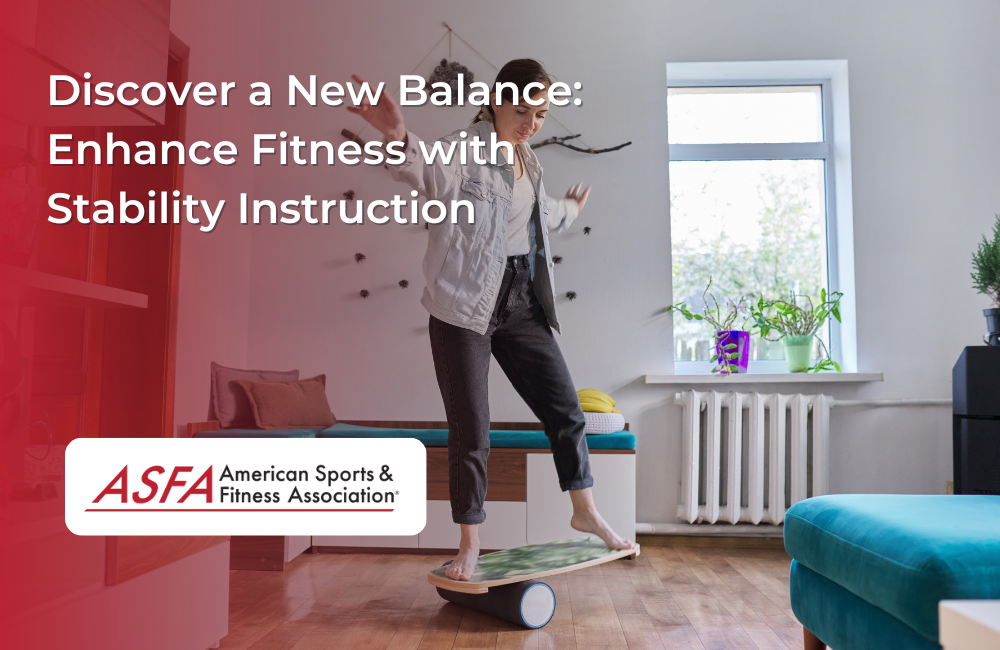Balance is an important part of staying healthy as you age. It can help you avoid falls and injuries, allowing you to enjoy an active lifestyle for years to come. But how do we improve our balance? One way is with stability instruction—a fitness class that focuses on improving posture and movement through exercises that require the use of both sides of the body at once. By helping clients develop stronger core muscles and improve their balance, stability instruction can also help them reduce their risk for falls later in life while staying engaged with fun exercises they'll enjoy doing together.
Balance is an essential part of fitness.
Balance is an essential part of fitness. It's important for safety and health, physical activity, mental health, and social interactions. Balance helps you do everything from the mundane to the adventurous: it makes you stronger; it keeps you from falling down; it improves how well your body performs during sports and work activities; it helps boost confidence in social situations (including dating!).
Stability instruction is a great way to develop balance.
Stability instruction is a great way to develop balance. Stability exercises are easy to do and don't require equipment. You can perform them anywhere, even at home!
Improving your balance can help prevent injury and falls, making you feel more confident in yourself. It's also easy! Here are some examples of basic stability exercises:
- Standing on one leg while keeping the other leg straight (use a wall or partner for support if needed)
- Squatting down with knees bent until thighs are parallel with the floor (use hands on hips for support)
Different stability exercises are best for different types of balance issues.
The different types of balance issues are:
- Hip instability (lack of strength in the hip muscles)
- Knee instability (lack of strength in the knee muscles)
- Ankle instability (lack of strength in the ankle muscles)
The following stability exercises are best for addressing these issues:
- Single-leg stance with a ball between your feet, keeping your hips level and spine straight. This exercise works on hip stability.
- Standing on one foot while holding onto an object like a chair or table leg. This exercise works on knee and ankle stability.
You can modify these exercises by increasing or decreasing the difficulty level by changing how far away from your body you hold onto something for support; or by changing where on your body you place the ball between your feet if doing so makes it easier or harder for you to maintain balance during this exercise routine
Try these stability exercises with your clients to help them improve their balance.
If you're looking for ways to improve your client's balance, here are some stability exercises that can help.
- Stability Ball Rollout: Place the ball in front of you and lie on your back with your feet flat on the floor. Place one hand on the ball and extend both arms over your head so that they are perpendicular with respect to each other, forming a "T". Roll out as far as possible without letting either hip drop or raising off of the floor (you may need to lift yourself slightly by pushing into your heels). Return slowly until coming back into starting position; repeat 5 times per side.
- Single Leg Balance: Stand facing forward with both feet together about hip-width apart then raise one leg up behind you while keeping both knees straight but not locked out (like doing a single leg squat). Hold this position for 30 seconds before switching sides; repeat 3 times per side with each leg lifted at least once during each set of repetitions
Consider jumping rope as a way to improve proprioception, which helps you keep track of where your body parts are in space.
Jumping rope is a great way to improve proprioception, which helps you keep track of where your body parts are in space. Proprioception is the ability to sense and control your body in space. Balance is an essential part of fitness, as it can help you get rid of tension and stress while improving performance in many areas of life.
Large muscle contractions help build strength and endurance in the muscles used for posture and movement.
Large muscle contractions help build strength and endurance in the muscles used for posture and movement.
- Isometric exercises are a form of resistance training that uses static positions to strengthen muscles without changing their length. They're especially helpful if you have muscle weakness or a limited range of motion in certain joints, such as the knees or ankles, which can cause imbalances that contribute to falls later in life.
- Examples include:
- Squatting with one leg extended behind you on a chair (hold this position for 30 seconds). - "Walking" with your arms outstretched at chest height while balancing on one leg (walk 10 steps forward then 10 steps back).
- How to do it: Stand with feet shoulder-width apart; keep knees bent slightly; lower yourself into a squatting position while keeping back straight; hold for 30 seconds before returning upright again
Isometric exercises can be especially helpful if you have muscle weakness or a limited range of motion in certain joints, such as the knees or ankles, which can cause imbalances that contribute to falls later in life.
Isometric exercises can be especially helpful if you have muscle weakness or a limited range of motion in certain joints, such as the knees or ankles, which can cause imbalances that contribute to falls later in life.
Isometrics are static, meaning they don't require movement. They work by increasing muscle strength through resistance at one joint angle while maintaining other angles around it--for example, holding your arm straight out while keeping your elbow locked at 90 degrees (a position known as shoulder flexion). You might also see isometric hip adduction and abduction exercises where a person holds their leg close to their body by squeezing their inner thigh muscles together; this helps strengthen those muscles so they can better support the pelvis when walking or running downhill on uneven terrain.
You don't have to go far to improve your balance
You don't have to go far to improve your balance. Balance exercises can be done at home, the gym, in a park, or even at work!
Balance exercises are helpful for strength training, posture, and flexibility. As you strengthen the muscles in your feet and ankles, you will increase your stability on uneven surfaces as well as improve balance overall. These exercises will also tone up any other muscles that support the legs such as those in the buttocks and thighs.
Conclusion
A regular program of stability instruction can help you maintain good balance and prevent falls. If you're looking for ways to improve your fitness and prevent injuries, try some of these exercises!





